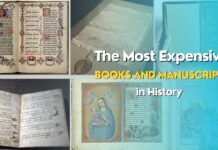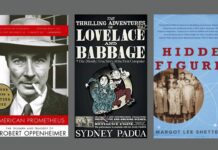Reading expands our minds and opens doors to new worlds, insights, and perspectives. With so many great books out there, it’s hard to narrow down a definitive lifetime reading list. But here’s a diverse selection of 50 brilliant, thought-provoking, and influential novels, memoirs, and nonfiction works by renowned authors across genres that belong on any book lover’s bucket list.
1. “1984,” George Orwell
George Orwell’s dystopian masterpiece “1984” depicts a chilling totalitarian future society where citizens are under constant government surveillance. The book focuses on Winston Smith, a low-ranking Inner Party member secretly keeping a diary, a forbidden act known as “thoughtcrime.” Winston and his lover Julia attempt to rebel against Big Brother’s oppressive regime. Still deeply relevant today, “1984” highlights themes of propaganda, psychological manipulation, authoritarian control, and the power of language.
First published: 1949
2. “A Christmas Carol,” Charles Dickens
Charles Dickens’ beloved novella “A Christmas Carol” tells the story of bitter miser Ebenezer Scrooge’s moral transformation. On Christmas Eve, Scrooge is visited by the ghost of his dead business partner Jacob Marley and the Ghosts of Christmas Past, Present, and Future. This vivid journey through time opens Scrooge’s eyes to his callousness and need for compassion. An immediate classic, this heartwarming tale of redemption remains a holiday favorite.
First published: 1843
3. “A Fine Balance,” Rohinton Mistry
Rohinton Mistry’s sweeping novel “A Fine Balance” chronicles the intertwining lives of four characters – Dina Dalal, Maneck Kohlah, Ishvar Darji, and his nephew Omprakash Darji – struggling to survive in 1970s India during the “Emergency” period of civil unrest and crackdowns. This richly layered epic confronts injustice, hardship, and the human capacity for cruelty as well as kindness. An illuminating window into a turbulent time in India’s history.
First published: 1995
4. “A Tree Grows in Brooklyn,” Betty Smith
Betty Smith’s poignant coming-of-age novel “A Tree Grows in Brooklyn” follows bright young Francie Nolan growing up in early 1900s Brooklyn. Despite challenges like poverty, alcoholism, and loss, Francie finds joy in school, reading, and dreaming of a better future. With profound empathy, Smith captures a resilient child navigating adversity in an unforgiving world.
First published: 1943
5. “Alice’s Adventures in Wonderland,” Lewis Carroll
Lewis Carroll’s beloved classic “Alice’s Adventures in Wonderland” plunges readers into an absurd, whimsical fantasy realm. After chasing the White Rabbit down a rabbit hole, young Alice encounters surreal characters like the Mad Hatter, March Hare, Cheshire Cat, and the formidable Queen of Hearts presiding over a bizarre tea party and croquet match. Carroll’s pioneering literary nonsense story has endured as a masterpiece of imagination.
First published: 1865
6. “Angela’s Ashes,” Frank McCourt
Frank McCourt’s Pulitzer Prize-winning memoir “Angela’s Ashes” chronicles his impoverished childhood in 1930s Limerick, Ireland. Struggling against perpetual hunger, illness, and losing three siblings to early deaths, McCourt’s family faces harrowing adversity. Yet he movingly captures his parents’ fierce love and youthful determination to find moments of humor and hope. A testament to human resilience.
First published: 1996
7. “Annie John,” Jamaica Kincaid
Jamaica Kincaid’s lyrical coming-of-age novel “Annie John” intimately depicts a mother-daughter relationship shifting from adoration to adolescent rebellion. Annie John’s devotion to her mother on their idyllic Caribbean island becomes complicated by growing up and changing priorities. Kincaid evocatively renders a young girl’s dawning self-awareness and emerging independence.
First published: 1985
8. “Beloved,” Toni Morrison
Toni Morrison’s acclaimed novel “Beloved” illuminates the trauma of slavery through the story of Sethe, an escaped slave who kills her baby daughter to prevent her from being captured. Haunted by her past, Sethe is confronted again by this loss years later in the form of a mysterious young woman called Beloved. A riveting exploration of memory, origins, and the lingering impact of brutality.
First published: 1987
9. “The Catcher in the Rye,” J.D. Salinger
J.D. Salinger’s influential coming-of-age novel “The Catcher in the Rye” remains a classic portrait of teenage rebellion and angst. Disaffected sixteen-year-old prep school student Holden Caulfield narrates with cynicism, humor, and vulnerability during his lonely wanderings around 1950s New York City. Salinger’s singular voice beautifully captures the restlessness of youth.
First published: 1951
10. “The Color Purple,” Alice Walker
Alice Walker’s renowned epistolary novel “The Color Purple” tells the story of Celie, a young black woman in the American South during the 1930s enduring abuse and oppression. Her letters detail her loving relationship with blues singer Shug Avery and her gradual empowerment and liberation. Walker compassionately explores trauma and resilience through intimate first-person storytelling.
First published: 1982
11. “The Diary of a Young Girl,” Anne Frank
Dutch Jewish teenager Anne Frank’s profoundly moving Holocaust memoir “The Diary of a Young Girl” records her family’s two years in hiding in Nazi-occupied Amsterdam. With humor, anger, hope, and heartbreaking honesty, Anne’s diary intimately captures attempts at normalcy in unthinkable circumstances. A lasting testament to courage and humanity in darkness.
First published: 1947
12. “East of Eden,” John Steinbeck
John Steinbeck’s ambitious epic “East of Eden” retells the biblical story of Cain and Abel against the backdrop of early 20th century California. At the book’s center are two families – the Trasks and the Hamiltons – whose interwoven fates embody the enduring conflict between good and evil. Steinbeck explores human nature in this sprawling but intimate tapestry of American dreams and failures.
First published: 1952
13. “Fierce Attachments: A Memoir,” Vivian Gornick
Vivian Gornick’s acclaimed memoir “Fierce Attachments” examines her volatile lifelong relationship with her intelligent but bitter mother. Their contentious dynamic in 1940s Bronx poignantly defines Gornick’s coming-of-age and eventual shift towards independence and self-realization. Gornick dissects the complexity of family bonds with remarkable candor and insight.
First published: 1987
14. “Frankenstein,” Mary Shelley
Mary Shelley’s gothic masterpiece “Frankenstein” invented the modern science fiction genre. Shelley chillingly imagines an ambitious scientist discovering the secret of bestowing life, but then recoiling from the hideous creature he constructs. This cautionary tale of human arrogance and responsibility is as relevant today as when published in 1818. Deeply influential and tremendously suspenseful.
First published: 1818
15. “The Grapes of Wrath,” John Steinbeck
John Steinbeck’s Pulitzer Prize-winning 1939 novel “The Grapes of Wrath” stands as a towering achievement in American literature. It chronicles the devastating journey of the Joad family among migrating farmers displaced from Oklahoma by drought and hardship. Their search for opportunity in California movingly depicts the struggles of the poor during the Great Depression.
First published: 1939
16. “The Handmaid’s Tale,” Margaret Atwood
Margaret Atwood’s dystopian masterwork “The Handmaid’s Tale” envisions the totalitarian Republic of Gilead, where fertile women are forced into child-bearing servitude. Narrator Offred’s poignant diary entries recount daily oppression and memories of freedom as she navigates her new reality. A chilling story that illuminates gender inequality and extremism.
First published: 1985
17. “Invisible Man,” Ralph Ellison
Ralph Ellison’s seminal 1952 novel “Invisible Man” depicts an unnamed black man’s experiences with racism and marginalization in mid-20th century America. Deeply philosophical, the surreal, nonlinear narrative explores invisibility, identity, society’s institutions, and shaping one’s own destiny as a person of color. An enduring classic work of African-American literature.
First published: 1952
18. “Jane Eyre,” Charlotte Brontë
Charlotte Brontë’s beloved gothic romance novel “Jane Eyre” tells the story of its titular heroine, an orphan who becomes a governess at Thornfield Hall and falls in love with her brooding employer, Edward Rochester. After uncovering Rochester’s dark secrets, Jane must ultimately choose between love and moral integrity. An enthralling, groundbreaking feminist coming-of-age story.
First published: 1847
19. “The Joy Luck Club,” Amy Tan
Amy Tan’s bestselling debut novel “The Joy Luck Club” weaves together four immigrant mothers’ stories of hardship and hope in China with their four Chinese-American daughters grappling with cultural identity in San Francisco. By revealing their profound mother-daughter bonds, Tan beautifully explores the complexities of family, heritage, and the Chinese-American experience.
First published: 1989
20. “The Jungle,” Upton Sinclair
Upton Sinclair’s impactful 1906 novel “The Jungle” exposed harrowing conditions and exploitation of immigrants in Chicago’s meatpacking industry, galvanizing public support for regulations to improve food safety and workers’ rights. Sinclair tells this vivid story of struggle through the eyes of Jurgis Rudkus, a Lithuanian immigrant seeking opportunity in America. A powerful depiction of turn-of-the-century labor struggles.
First published: 1906
21. “Lord of the Flies,” William Golding
William Golding’s iconic 1954 novel “Lord of the Flies” strand a group of British schoolboys on an uninhabited island, where their attempts at democratic order devolve into primal chaos. As Golding dissects toxic masculinity and humanity’s innate savagery lurking under civilization’s surface, the story becomes a parable for decadence, tyranny, and human nature’s dark impulses.
First published: 1954
22. “The Metamorphosis,” Franz Kafka
Franz Kafka’s landmark 1915 novella “The Metamorphosis” begins with traveling salesman Gregor Samsa suddenly transformed into a “monstrous verminous bug,” still possessing human intelligence and emotion. As his frustrated family struggles to cope, Kafka exposes penetrating truths about alienation, humanity, and society’s materialistic pressures. Strange yet profoundly relatable.
First published: 1915
23. “Moby-Dick,” Herman Melville
The epic saga Moby-Dick follows whaling ship captain Ahab’s obsessive quest to kill the great white whale who bit off his leg on a previous voyage. Herman Melville’s masterful narrative infuses maritime adventure, rich symbolism, and encyclopedic details on 1800s whaling, while examining dark truths about revenge and the human psyche. An American classic.
First published: 1851
24. “Murder on the Orient Express,” Agatha Christie
The most famous work by mystery novelist Agatha Christie, “Murder on the Orient Express” features eccentric sleuth Hercule Poirot. When a passenger is murdered on a stranded train, Poirot investigates the peculiar assortment of international travelers in the claustrophobic setting. Witty and suspenseful with an ingenious solution that has delighted readers for decades.
First published: 1934
25. “One Flew Over the Cuckoo’s Nest,” Ken Kesey
Ken Kesey’s countercultural classic “One Flew Over the Cuckoo’s Nest” is narrated by Native American mental hospital patient Chief Bromden, observing fellow inmate Randle McMurphy’s clashes with the institution’s oppressive Nurse Ratched. A fierce critique of societal norms and an inspiring story of standing up against authority run amok.
First published: 1962
26. “One Hundred Years of Solitude,” Gabriel García Márquez
Gabriel García Márquez pioneered magical realism with this expansive 1967 novel chronicling seven generations of the Buendía family in the fictional village Macondo. Blending fantastical elements with historical events in Colombia, Márquez crafts an astonishingly rich tapestry and an absorbing family saga through a century of change.
First published: 1967
27. “Oryx and Crake,” Margaret Atwood
Margaret Atwood’s 2003 novel “Oryx and Crake” imagines a dystopian future where corporations rule and genetic engineering has devastated humanity. Narrator Snowman is seemingly the last Homo sapiens, haunted by memories of his enigmatic friend Crake, who caused global disaster, and their shared lover Oryx. A prescient cautionary tale of science unchecked by ethics.
First published: 2003
28. “The Outsiders,” S.E. Hinton
S.E. Hinton’s seminal 1967 young adult novel “The Outsiders” is an emotionally gripping coming-of-age story. Narrated by teenaged Ponyboy Curtis, it portrays the fierce divisions between the wealthy “Socs” and working-class “Greasers” in 1960s Oklahoma, as tragic events unfold. Raw, relatable, and socially relevant, this book still deeply resonates with modern readers.
First published: 1967
29. “The Picture of Dorian Gray,” Oscar Wilde
Oscar Wilde’s only novel “The Picture of Dorian Gray” follows the moral descent of beautiful young aristocrat Dorian, who remains youthful while his portrait ages and manifests his vices. A mesmerizing gothic tale of vanity, virtue, and dark obsession, laced with Wilde’s signature wit. Deeply subversive for Victorian England with enduring influence.
First published: 1890
30. “Pride and Prejudice,” Jane Austen
Jane Austen’s beloved romantic comedy “Pride and Prejudice” revolves around the tangled courtship between opinionated Elizabeth Bennet and haughty Mr. Darcy in early 19th century England. Austen wittily explores manners, social expectations, reputation, and marriage through their enemies-to-lovers relationship, crafting an effervescent and unforgettable love story.
First published: 1813
31. “The Scarlet Letter,” Nathaniel Hawthorne
Nathaniel Hawthorne’s 1850 novel “The Scarlet Letter” dissects guilt, revenge, judgment, and morality in Puritan Massachusetts Bay Colony. Protagonist Hester Prynne is shunned as an adulteress, forced to wear a scarlet “A”, but defiance reveals her inherent dignity. A profound early masterpiece of American literature.
First published: 1850
32. “Slaughterhouse-Five,” Kurt Vonnegut
Kurt Vonnegut’s 1969 anti-war novel “Slaughterhouse-Five” combines historical fiction and science fiction to depict the Allied firebombing of Dresden in World War II, which Vonnegut survived. Framed using time travel and Tralfamadorian philosophy, the tragic events interrogate free will, memory, and the nature of reality. A genre-bending book about humanity’s capacity for both evil and good.
First published: 1969
33. “Snow Crash,” Neal Stephenson
Neal Stephenson’s pioneering 1992 sci-fi novel “Snow Crash” envisions a privatized, corporatized near-future America where virtual reality, ancient Sumerian mythology, and a computer virus threaten civilization. Protagonist Hiro Protagonist investigates the origins of the mysterious drug/computer virus Snow Crash in frenetic cyberpunk adventures across real and virtual spaces. A captivating literary ride at the dawn of the internet era.
First published: 1992
34. “Song of Solomon,” Toni Morrison
In this 1977 novel, Toni Morrison transfixingly chronicles a black man named Milkman Dead coming of age in Michigan and embarking on a quest for identity and ancestral roots in the South. Lyrical magical realism interweaves African-American folklore, myth, and history in Milkman’s epic spiritual journey towards self-discovery and belonging.
First published: 1977
35. “Sula,” Toni Morrison
Toni Morrison’s 1973 novel “Sula” centers on an uncanny female friendship between opposites: Nel Wright, who conforms to societal expectations, and Sula Peace, who defiantly flouts conventions. Spanning from childhood to adulthood in an Ohio town, this rich portrayal of intimacy, identity, and the burden of secrets is considered one of Morrison’s finest works.
First published: 1973
36. “Their Eyes Were Watching God,” Zora Neale Hurston
Zora Neale Hurston’s 1937 masterwork “Their Eyes Were Watching God” follows independent, strong-willed Janie Crawford on a quest for fulfillment and true love in Florida during the early 20th century. Written in vernacular African-American dialect, the lyrical self-realization journey beautifully expresses rural Southern black culture. A trailblazing feminist novel.
First published: 1937
37. “Things Fall Apart,” Chinua Achebe
Chinua Achebe’s groundbreaking 1959 novel “Things Fall Apart” details the clash between white Christian colonists and the traditional Igbo community in late 19th century Nigeria through protagonist Okonkwo. The first African novel published in English, Achebe movingly portrays the human impacts of colonialism and Igbo cultural identity. A modern classic.
First published: 1958
38. “To Kill a Mockingbird,” Harper Lee
Harper Lee’s Pulitzer Prize-winning 1960 novel “To Kill a Mockingbird” unfurls from a child’s perspective against the backdrop of racial injustice in 1930s Alabama. Compassionate lawyer Atticus Finch defends a black man accused of rape, and his kids learn about empathy and courage. Lee beautifully expresses loss of innocence, morality, justice, and racism’s toll.
First published: 1960
39. “The Unbearable Lightness of Being,” Milan Kundera
Czech author Milan Kundera’s 1984 novel “The Unbearable Lightness of Being” philosophically explores love, politics, and human existence through the interconnected lives of womanizing surgeon Tomas, his photographer lover Tereza, and her dramatic mistress Sabina, set against the 1968 Prague Spring uprising and its aftermath. A profound, idiosyncratic meditation on choice, uncertainty, and weighty consequences.
First published: 1984
40. “Howards End,” E.M. Forster
Regarded as Forster’s most acclaimed work, Howards End takes place in Edwardian England and follows the lives of three distinct families: the affluent and influential Wilcoxes, the cultured and empathetic Schlegels, and the impoverished working-class Basts. Forster skillfully explores themes of class struggle, the evolving role of women, and the clash between rural and urban values through his depiction of these three families and their interactions. The novel served as the inspiration for the captivating 1992 romantic drama featuring the talented cast of Anthony Hopkins, Helena Bonham Carter, and Emma Thompson.
Originally published in 1910














![Technical Aspects of 844 Area Code in 2024 [Detail Guide] 844 Area Code](https://articleify.com/wp-content/uploads/2024/01/844-Area-Code-150x150.jpg)














